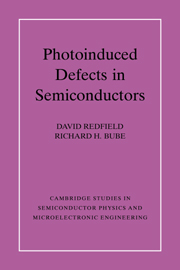Book contents
- Frontmatter
- Contents
- Preface
- 1 Introduction: Metastable Defects
- 2 III–V Compounds: DX and EL2 Centers
- 3 Other Crystalline Materials
- 4 Hydrogenated Amorphous Silicon: Properties of Defects
- 5 Hydrogenated Amorphous Silicon: Photoinduced Defect Kinetics and Processes
- 6 Other Amorphous Semiconductors
- 7 Photoinduced Defects in Devices
- References
- Index
5 - Hydrogenated Amorphous Silicon: Photoinduced Defect Kinetics and Processes
Published online by Cambridge University Press: 15 December 2009
- Frontmatter
- Contents
- Preface
- 1 Introduction: Metastable Defects
- 2 III–V Compounds: DX and EL2 Centers
- 3 Other Crystalline Materials
- 4 Hydrogenated Amorphous Silicon: Properties of Defects
- 5 Hydrogenated Amorphous Silicon: Photoinduced Defect Kinetics and Processes
- 6 Other Amorphous Semiconductors
- 7 Photoinduced Defects in Devices
- References
- Index
Summary
Kinetics of Generation and Annealing of Photoinduced Defects
In efforts to elucidate the nature and origin of the metastable defects induced by light in a-Si:H (Staebler and Wronski 1977), there have been many studies of the kinetics of their generation and annealing. Although such studies do not establish any microscopic models, they can provide significant guides as to which models may be acceptable. In the interpretation of such studies it is useful to be mindful of the various other ways of producing dangling-bond defects with similar properties. In particular, the observation that such defects can also be produced in the dark by passage of forward current in a p–i–n device (Staebler et al. 1981) has led to the general belief that the defects are not produced by the light directly, but rather by the energy released when excess carriers recombine (Staebler et al. 1981) or are captured (Crandall 1991) at a localized center. Another significant observation is that light of photon energies down to and below 1 eV can cause this degradation even though the band gap is ≈ 1.75 eV.
The earliest observations of photoinduced degradation of lightly doped a-Si:H – the Staebler–Wronski effect – found that both the dark conductivity and photoconductivity decreased as a result of light exposure (see Fig. 1.2), and that these effects could be annealed away at about 150 °C for a few hours (Staebler and Wronski 1977). Thus there were two kinetic terms evident for the rate of change of the defect density N: a positive, defect-generating term that must contain the light intensity, and a negative, thermal annealing term.
- Type
- Chapter
- Information
- Photo-induced Defects in Semiconductors , pp. 113 - 174Publisher: Cambridge University PressPrint publication year: 1996
- 1
- Cited by



